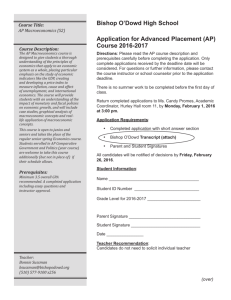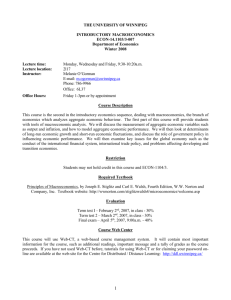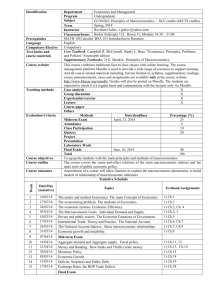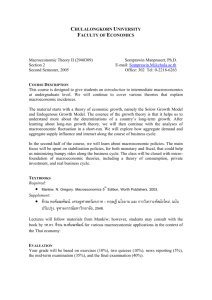Intermediate Macroeconomics (V31.0012.011) Chetan Dave Spring 2011 Mondays and Wednesdays, 11:00am‐12:15pm
advertisement
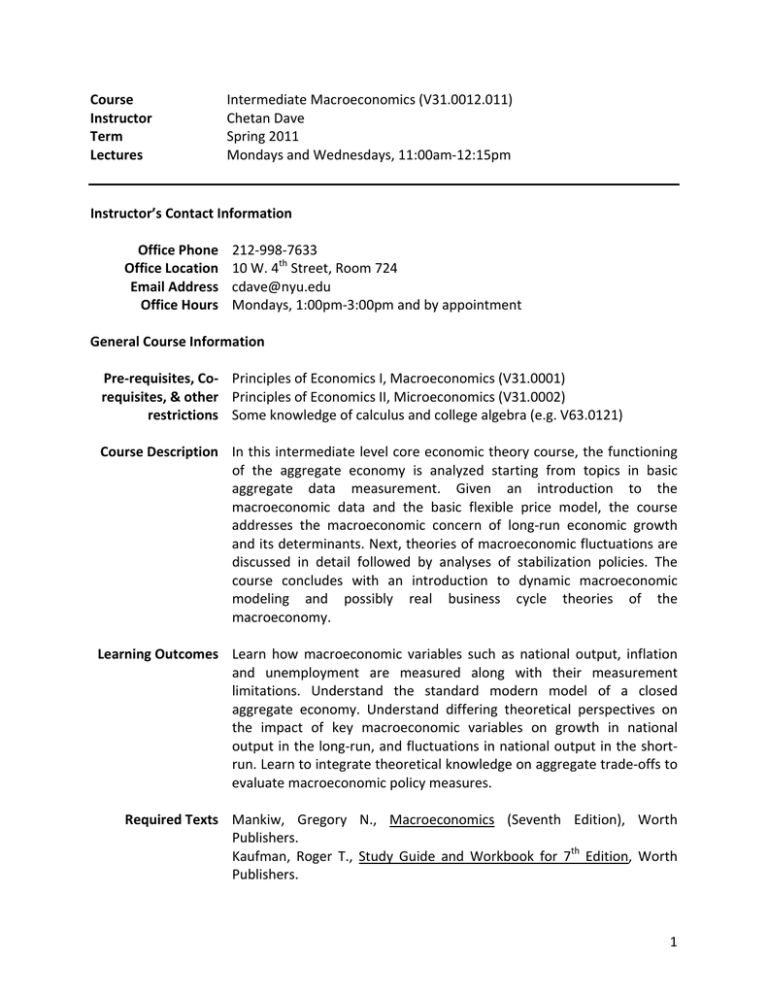
Course Intermediate Macroeconomics (V31.0012.011) Instructor Chetan Dave Term Spring 2011 Lectures Mondays and Wednesdays, 11:00am‐12:15pm Instructor’s Contact Information Office Phone 212‐998‐7633 Office Location 10 W. 4th Street, Room 724 Email Address cdave@nyu.edu Office Hours Mondays, 1:00pm‐3:00pm and by appointment General Course Information Pre‐requisites, Co‐ Principles of Economics I, Macroeconomics (V31.0001) requisites, & other Principles of Economics II, Microeconomics (V31.0002) restrictions Some knowledge of calculus and college algebra (e.g. V63.0121) Course Description In this intermediate level core economic theory course, the functioning of the aggregate economy is analyzed starting from topics in basic aggregate data measurement. Given an introduction to the macroeconomic data and the basic flexible price model, the course addresses the macroeconomic concern of long‐run economic growth and its determinants. Next, theories of macroeconomic fluctuations are discussed in detail followed by analyses of stabilization policies. The course concludes with an introduction to dynamic macroeconomic modeling and possibly real business cycle theories of the macroeconomy. Learning Outcomes Learn how macroeconomic variables such as national output, inflation and unemployment are measured along with their measurement limitations. Understand the standard modern model of a closed aggregate economy. Understand differing theoretical perspectives on the impact of key macroeconomic variables on growth in national output in the long‐run, and fluctuations in national output in the short‐ run. Learn to integrate theoretical knowledge on aggregate trade‐offs to evaluate macroeconomic policy measures. Required Texts Mankiw, Gregory N., Macroeconomics (Seventh Edition), Worth Publishers. Kaufman, Roger T., Study Guide and Workbook for 7th Edition, Worth Publishers. 1 Assignments and Academic Calendar Week Topic (Approximate) 1 Introduction: Aims and Objectives 2 Macroeconomic Data 3 The Basic Flexible Price Model 4 Money and Inflation under Flexible Prices 5 Unemployment under Flexible Prices 6 The Very Long Run: Exogenous Economic Growth 7 The Very Long Run: Exogenous Economic Growth (cont’d.) 8 The Very Long Run: Endogenous Economic Growth 9 The Basic Sticky Price Model Exam # 1 (Chapters 1, 2, 3, 4, 6, 7, 8) 10 Aggregate Demand I: Building the IS‐LM Model 11 Aggregate Demand II: Building the AD Model 12 Short Run Aggregate Supply and the Inflation‐ Unemployment Tradeoff 13 Dynamic Macroeconomics 14 Stabilization Policy 15 Government Debt Exam # 2 (Chapters 10, 11, 13, 14, 15, 16) Textbook Readings Chapter 1 Chapter 2 Chapter 3 Chapter 4 Chapter 6 Chapter 7 Chapter 7 (cont’d.) Chapter 8 Chapter 9 Chapter 10 Chapter 11 Chapter 13 Chapter 14 Chapter 15 Chapter 16 2 Course Policies Grading Criteria Each of the two exams count for 40% of the final grade. Assignments will be handed out throughout the term and they will count for a total of 20% of the final grade. The economics department curve for non‐ principles courses assigns grades of A or A‐ to the top 29% of the class and grades of B+, B or B‐ to the next 40% of the class. Grades are based solely on exams and assignments, there will be no extra credit or additional work in exchange for grades. The economics department grants incompletes only in genuine emergencies that are documented and approved by the department’s Director of Undergraduate Studies. Class Attendance Not required but highly recommended. Same applies for recitation sections. Classroom Students are expected to be diligent in the pursuit of their studies and Citizenship regular in their attendance. As noted above, class attendance is not required; failure to attend is at your own risk. You are responsible for any announcements made or information given during class, no excuses will be accepted. The exams will be based on lecture material and required readings. Some of the lecture material may not be in the readings and the student should have carefully read the material at least once before class. The same applies to recitation sections. Student Grievance Complaints and questions about exam grades must be submitted in Procedures writing, written responses will follow. The sequence to follow is: first contact your TA then if matters are unresolved you can appeal to the instructor. This syllabus is subject to change at the discretion of the Instructor. 3


